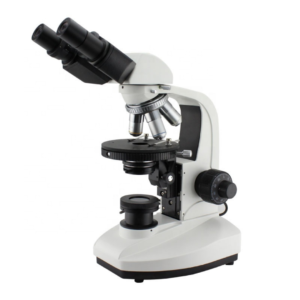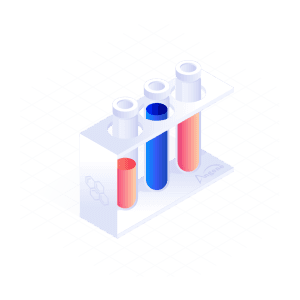$2,587.00
The Halogen Lamp Fluorescence Microscope produces images of stained tissues, animal and microbiological cell colonies, and pathogens irradiated with light. It utilizes specific wavelengths of light, particularly infrared light, to excite fluorophores in specimens infused with the fluorochrome pigment and thereby generates a highly illuminated image with distinguishable boundaries.
The primary purpose of the halogen lamp fluorescence microscope is to irradiate the specimen with a specific wavelength of light, separate the weaker emitted light from the bright excitation light, and only allow the emitted light to reach the detector. When light reaches the detector, the fluorescent structure of the specimen is superimposed against a deep, dark, almost black background.
ConductScience offers the Halogen Lamp Fluorescent Microscope.
AfaSci, Inc. is a biopharmaceutical company focused on discovering and developing innovative therapies for pain management and neurological disorders. Based in the San Francisco Bay Area, AfaSci specializes in non-opioid, non-NSAID solutions to address chronic pain, neuropathic conditions, and central nervous system diseases. Their research is centered around peptide and small molecule drugs, with several promising preclinical candidates targeting specific ion channels and enzymes involved in pain and inflammation. With a strong intellectual property portfolio and strategic partnerships with academic institutions, AfaSci is dedicated to advancing novel treatments that aim to improve patients' quality of life while reducing reliance on traditional painkillers.

bool(false)

bool(false)

| Eyepiece | WF 10X (Φ18mm) |
| Eyepiece Tube | Trinocular, inclined 30° |
| Objective | Achromatic 4X /0.10 Achromatic 10X /0.25 Achromatic 100X /1.25(Spring, Oil) Fluorescence 25X /0.65 |
| Focus System | Coaxial coarse/fine focus system, with tension adjustable and up stop, minimum division of fine focusing is 2.0μm |
| Nosepiece | Quadruple (Backward ball bearing inner locating) |
| Working Stage | Double-layer mechanical (Size: 135mmX125mm, moving range:75mmX35mm) |
| Abbe Condenser | N.A.1.25 Rack & pinion adjustable |
| Filter | Blue Filter Frosted Filter |
| Collector | For Halogen Lamp |
| Light Source | 6V 20W Halogen Lamp, adjustable brightness |
| Reflected Fluorescence System | Mercury Lamp House 100W/DC Power Supply Unit: AV: 110V or 220V Fluorescence filter system B Exciton Wavelength: 450~490nm Fluorescence filter system G Exciton Wavelength: 495~555nm |
The Halogen Lamp Fluorescence Microscope produces images of stained tissues, animal and microbiological cell colonies, and pathogens irradiated with light. It utilizes specific wavelengths of light, particularly infrared light, to excite fluorophores in specimens infused with the fluorochrome pigment and thereby generates a highly illuminated image with distinguishable boundaries.
The Fluorochrome pigments or fluorophore probes are stains that cling to the visible and subvisible structures of the specimen, have high specificity for the target structure, and also have higher emission to absorption ratio. Fluorochromes absorb irradiated light and emit photons long after the light source has been used, thus illuminating the attached molecules. Though the fluorescence microscope can illuminate distinctive molecules simultaneously, it cannot dispense spatial resolution below the diffraction capacity of the molecules. In simpler terms, illumination intensity is also determined by the light-emitting property of the specimen used.
The source of illumination in the microscope is the tungsten halogen lamp enclosed in a reflective casing that focuses the light wavelength through a collector lens into the substage condenser.
The primary purpose of the halogen lamp fluorescence microscope is to irradiate the specimen with a specific wavelength of light, separate the weaker emitted light from the bright excitation light, and only allow the emitted light to reach the detector. When light reaches the detector, the fluorescent structure of the specimen is superimposed against a deep, dark, almost black background. Essentially, the darkness of the background determines the efficiency of the detector, i.e., the darker the background, the greater the efficiency of the detector, and the higher the contrast in the image produced.
The halogen fluorescence microscope has an illuminator with a light source at one end and a filter at the other end. Tungsten halogen lamps used in the fluorescence microscope generate a continuous spectrum of light that stays incredibly uniform throughout the working capacity of the lamp. The wavelength of light generated by the tungsten halogen lamp releases precarious levels of heat that are contained inside the casing with ample layers of insulating sheets. An adjustable rheostat assimilated in the microscope stand controls the lamp voltage.
Also integrated as an adjustable knob in the microscope stand, the potentiometer controls the direct current voltage that operates the tungsten halogen lamp. Incoming light from the lamp travels through the casing to reach the collector lens of the microscope, the sintered glass diffuser, and finally to the condenser incorporated in the microscope aperture.
Light of the desired wavelength produced inside the microscope with a multispectral halogen lamp passes through an excitation filter that eliminates undesirable wavelengths. Next in the pathway of the wavelength is the beam splitter or dichromatic mirror, which reflects and disperses the filtered wavelength.
The specimen with fluorescing pigments fluoresces upon irradiation by the incoming wavelength and emits its own light that strikes back on the dichromatic mirror and gets reflected. Once reflected, the emitted light is filtered by the emission filter that eradicates undesirable wavelengths of excitation light. The resultant emitted light finally produces an image.
Prepare the specimen that is to be examined and use fluorescein pigments if required. After preparing the specimen, plug the electric lead of the microscope into a properly grounded outlet and turn on the switch. Once the system starts running, choose the objective and place the specimen on the microscope stage. Add oil or water according to the protocol of the specimen and adjust the objective to the working distance by rotating the knob.
Place the DIC prism in the objective and match the prism with the objective as close to the microscope’s list. Adjust the condenser turret to align it with the two prisms of the condenser and the objective. To balance the contrast, use the wheel on the polarizer located under the condenser. Observe the specimen directly through the eyepiece and adjust the focal point by rotating the knob. Rotate the wheel to increase or decrease the light intensity as per requirement.
To replace the lamp, wear heat-insulating gloves and remove the lamp from the plastic covering provided by the manufacturer. Cut the plastic covering with a pair of scissors just near the tungsten pins and place the lamp in the lamp holder, all while keeping the covering intact. Remove the plastic covering once the lamp is successfully seated in its holder.
Tungsten halogen lamps, when illuminated, dissipate tremendous levels of heat and therefore should be operated with caution. When using a fluorescence microscope with a tungsten halogen lamp light source, ensure to follow the handling instructions from the manufacturers. If a tungsten halogen lamp has to be changed, avoid holding the lamp envelope with bare hands as the prints might burn into the glass, reducing the longevity of the lamp. Allow the lamp to cool for at least half an hour before beginning the replacement process.
Somatic nuclear transfer is a procedure conducted to clone desirable animal species and involves the removal of nuclear material (enucleation) from the recipient matured oocytes of the animal. Iwamoto et al. (2015) attempted the cloning of bovine embryos. They replaced the nuclear material of matured oocytes with that of the donor cells and fertilized them in vitro with spermatozoa.
They first isolated the oocytes, placed them in paraffin oil, and injected the antibody pigment with fluorescent photo erythrocin in the cytoplasm using a pipette. A fluorescence microscope with a 100-watt halogen lamp was used to observe the chromosomes of the irradiated oocytes. For nuclear transfer, they obtained donor cells by isolating bovine fibroblasts from the ear skin cells of a 5-month-old Japanese male black calf. The oocytes injected with the antibody and observed with fluorescence microscopy exhibited higher success rates of enucleation than oocytes cloned with blind enucleation.
In another study, Steinbauer, Harris, Abels, and Messmer (2000) performed an experiment to determine the threshold of fluorescent light before fluoro phototoxic effects begin to damage hamster specimens during fluorescence microscopy. They conducted the investigation in three stages.
In the first stage, they irradiated the hamster dorsal skinfold chamber infused with two different concentrations (groups A and B) of the fluorescein isothiocyanate dextran to 60 min of fluorescence using a fluorescence microscope. In the next stage, they subjected the two groups to pressure-induced ischemia for 4 hours (groups C and D).
In the last stage, they observed the presence of ischemia in the microcirculation of the hamster dorsal skinfold using two techniques of standardized intravital microscopic examination. Groups I and II (post-ischemia) injected with isothiocyanate were analyzed with epi-illumination, and Group III was examined with trans-illumination only. Results exhibited no significant adverse effects with epi-illumination and fluorescence dyes. However, the research notified the importance of phototoxic risk assessment when performing ischemia-reperfusion studies in animals.
Unlike older microscope models, contemporary microscopes such as the halogen lamp fluorescence microscope allow the adjustment of illumination to a relatively higher degree. Tungsten halogen lamps used in fluorescence microscopes provide light of varying wavelengths with an intensity high enough to excite the fluorophores.
The halogen fluorescence microscope is pre-set and does not involve an extensive protocol for its installation. They provide uniform illumination even at lower intensities. The halogen lamp has a color temperature close to the sun, producing images closest to their true color.
Specimens examined with fluoromicroscopy can be observed directly without the need for fixing reagents and time-consuming staining processes that affect cell vitality and experiment results. The highly specific fluorophores added to the specimen can illuminate and highlight the proteins that need to be studied.
Moreover, the fluorescence techniques produce a highly defined three-dimensional structure of the cell if used with confocal microscopy. With the advanced fluorophore probes, specific pigments can be added to identify multiple structures at the same time. Different pigments used simultaneously can illuminate different structures inside the cell for distinct identification.
Autofluorescent structures can be observed directly, but non-fluorescent structures have to be pigmented with a suitable fluorophore probe, so choosing the right one takes time and effort. Some specimens need multiple fluorophore probes to enable the illumination and identification of different structures. This might result in a below-par signal-to-color ratio due to the merging of the fluorophore probes. Though the fluorescence halogen lamps provide a wide range of light wavelengths, they have weak emission rates in the UV spectrum.
The color temperature values of the tungsten halogen lamp used in fluorescence microscopes diminish over time and can affect the lamp’s ability to render color to the microscopic image. Filaments of the tungsten-halogen bulb have exceptionally high operating temperatures and therefore require the use of specialized ventilated lamp casings equipped with heat sinks that help contain high heat levels. Additionally, the high amount of heat released by the halogen lamp desiccates the specimen or, worse, can destroy it.
Low wavelengths of light used to excite the fluorophores are particularly damaging to the DNA and cells in general. In the majority of experiments, cell observation is achieved before these effects can be exhibited. However, cumulative effects in studies involving repeated examinations may affect cell viability by increasing cell membrane permeability and degradation of cytoplasmic bodies. The fluorophores may sometimes cause an unfavorable mechanism called photobleaching and block the emission of fluorescence from the structures.
| Weight | 110.23 lbs |
|---|---|
| Dimensions | 75 × 55 × 35 cm |
| Brand | Microscopex |
| collector | |
| Device Type | Fluorescent Microscope |
| eyepiece | |
| eyepiece-magnification | |
| filter | |
| objective | Achromatic 100X /1.25(Spring, Oil), Achromatic 10X /0.25, Achromatic 4X /0.10, Fluorescence 25X /0.65 |
| Working Voltage | American Standard: ~110V/60HZ ~230V/50HZ |
You must be logged in to post a review.
There are no questions yet. Be the first to ask a question about this product.
Reviews
There are no reviews yet.